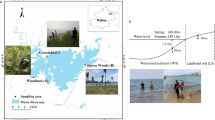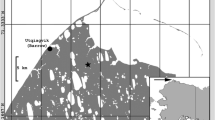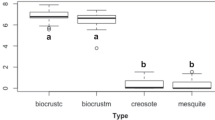Abstract
The rapid expansion of Phragmites australis in brackish marshes of the East Coast of the USA has drawn much attention, because it may change vegetation diversity and ecosystem functions. In particular, higher primary production of Phragmites than that of other native species such as Spartina patens and Schoenoplectus americanus has been noted, suggesting possible changes in carbon storage potential in salt marshes. To better understand the long-term effect of the invasion of Phragmites on carbon storage, however, information on decomposition rates of soil organic matter is essential. To address this issue, we compared microbial enzyme activities and microbial functional gene abundances (fungi, laccase, denitrifier, and methanogens) in three depths of soils with three different plants in a brackish marsh in Maryland, USA. Laccase and phenol oxidase activities were measured to assess the decomposition potential of recalcitrant carbon while β-glucosidase activity was determined as proxy for cellulose decomposition rate. Microbial activities near the surface (0–15 cm) were the highest in Spartina-community sites followed by Phragmites- and Schoenoplectus-community sites. A comparison of stable isotopic signatures (δ13C and δ15N) of soils and plant leaves suggests that deep organic carbon in the soils mainly originated from Spartina, and only the surface soils may have been influenced by Phragmites litter. In contrast, fungal, laccase, and denitrifier abundances determined by real-time qPCR exhibited no discernible patterns among the surface soils of the three vegetation types. However, the abundance of methanogens was higher in the deep Phragmites-community soil. Therefore, Phragmites invasion will accelerate CH4 emission by greater CH4 production in deep soils with abundant methanogens, although enzymatic mechanisms revealed the potential for larger C accumulation by Phragmites invasion in salt marshes in the east coast of the USA.




Similar content being viewed by others
References
Mitra S, Wassmann R, Vlek P (2005) An appraisal of global wetland area and its organic carbon stock. Curr Sci 88:25–35
Deegan LA, Johnson DS, Warren RS (2012) Coastal eutrophication as a driver of salt marsh loss. Nature 490:388–392
Kirwan ML, Guntenspergen GR, D’Alpaos A (2010) Limits on the adaptability of coastal marshes to rising sea level. Geophys Res Lett 37:23401
Bardgett RD, Freeman C, Ostle N (2008) Microbial contributions to climate change through carbon cycle feedbacks. ISME J 2:805–814
Chin Y, Aiken G, O’Loughlin E (1994) Molecular weight, polydispersity, and spectroscopic properties of aquatic humic substances. Environ Sci Technol 28:1853–1858
Baldrian P (2006) Fungal laccases—occurrence and properties. FEMS Microbiol Rev 30:215–242
Freeman C, Ostle N, Kang H (2001) An enzymic ‘latch’ on a global carbon store. Nature 409:149
Fourqurean J, Duarte C, Kennedy H (2012) Seagrass ecosystems as a globally significant carbon stock. Nat Geosci 5:505–509
Saltonstall K (2002) Cryptic invasion by a non-native genotype of the common reed, Phragmites australis, into North America. Proc Natl Acad Sci U S A 99:2445–2449
Artigas F, Shin JY, Hobble C, Marti-Donati A, Schafer K, Pechmann I (2015) Long term carbon storage potential and CO2 sink strength of a restored salt marsh in New Jersey. Agric For Meteorol 200:313–321
Uddin MN, Robinson RW, Caridi D, Harun AY (2013) Is phytotoxicity of Phragmites australis residue influenced by decomposition condition, time and density? Mar Freshw Res
Neubauer and Megonigal (2015) Moving beyond global warming potentials to quantify the climatic role of ecosystems. Ecosystems 18:1000–1013
Bridgham SD, Megonigal JP, Keller JK (2006) The carbon balance of North American wetlands. Wetlands 26(4):889–916
Dar SA, Kleerebezem R, Stams AJM, Kuenen JG, Muyzer G (2008) Competition and coexistence of sulfate-reducing bacteria, acetogens and methanogens in a lab-scale anaerobic bioreactor as affected by changing substrate to sulfate ratio. Appl Microbiol Biotechnol 78(6):1045–1055
Poffenbarger HJ, Needleman BA, Megonigal JP (2011) Salinity influence on methane emissions from tidal marshes. Wetlands 31:831–842
Rothman E, Bouchard V (2007) Regulation of carbon processes by macrophyte species in a Great Lakes coastal wetland. Wetlands 27:1134–1143
Mozdzer T, Megonigal P (2013) Increased methane emissions by an introduced Phragmites australis lineage under global change. Wetlands 33:609–615
Mueller P, Hager R, Meschter J, Mozdzer T, Langley J, Jensen K, Megonigal JP (2016) Complex invader-ecosystem interactions and seasonality mediate the impact of non-native Phragmites on CH4 emissions. Biol Invasions. https://doi.org/10.1007/s10530-016-1093-6
Martin R, Moseman-Valtierra S (2015) Greenhouse gas fluxes vary between Phragmites Australis and native vegetation zones in coastal wetlands along a salinity gradient. Wetlands 35:1102–1031
Caplan JS, Hager RN, Megonigal JP, Mozdzer TJ (2015) Global change accelerates carbon assimilation by a wetland ecosystem engineer. Environ Res Lett 10:115006
McCormick MK, Kettenring KM, Baron HM, Whigham DF (2010) Extent and reproductive mechanisms of Phragmites australis spread in brackish wetlands in Chesapeake Bay, Maryland (USA). Wetlands 30:67–74
Carney KM, Hungate BA, Drake BG, Megonigal JP (2007) Altered soil microbial community at elevated CO2 leads to loss of soil carbon. Proc Natl Acad Sci 104:4990–4995
Sinsabaugh RL, Carreiro MM, Repert DA (2002) Allocation of extracellular enzymatic activity in relation to litter composition, N deposition, and mass loss. Biogeochemistry 60:1–24
Pind A, Freeman C, Lock MA (1994) Enzymic degradation of phenolic materials in peatlands—measurement of phenol oxidase activity. Plant Soil 159:227–231
Wright AL, Reddy KR (2001) Phosphorous loading effects on extracellular enzyme activity in Everglades wetland soils. Soil Sci Soc Am J 53:1723–1729
Matsumura E, Shin T, Murao S, Yamamoto E, Kawano T (1987) New enzymatic colorimetric reactions of benzoic acid derivatives with ABTS 2, 20-azinobis-3-ethylbenzthiazoline-6-sulfonic acid diammonium salt in the presence of laccase. Agric Biol Chem 51:2743–2750
White T, Bruns T, Lee S, Taylor J, Innis M, Gelfand D, Sninsky J (1990) PCR protocols: a guide to methods and applications. Academic Press, New York
Luis P, Walther G, Jellner H, Martin F, Buscot F (2004) Diversity of laccase genes from basidiomycetes in a forest soil. Soil Biol Biochem 36:1025–1036
Lauber CL, Sinsabaugh RL (2009) Laccase gene composition and relative abundance in oak forest soil is not affected by short-term nitrogen fertilization. Soil Microbiol 57:50–57
Sinsabaugh RL, Moorhead DL (1994) Resource allocation to extracellular enzyme production: a model for nitrogen and phosphorus control of litter decomposition. Soil Biol Biochem 26:1305–1311
Luesters T, Friedrich NW (2003) Evaluation of PCR amplification bias by terminal restriction fragment length polymorphism analysis of small-subunit rRNA and mcrA genes by using defined template mixtures of methanogenic pure cultures and soil DNA extracts. Appl Environ Microbiol 69:32–326
Liu X, Tiquia SM, Holguin G, Wu L, Nold SC, Devol AH, Luo K, Palumbo AV, Tiedje JM, Zhou J (2003) Molecular diversity of denitrifying genes in continental margin sediments within the oxygen-deficient zone off the Pacific Coast of Mexico. Appl Environ Microbiol 69:3249–3560
Chimney MJ, Pietro KC (2006) Decomposition of macrophyte litter in a subtropical constructed wetland in South Florida. Ecol Eng 27:301–321
Kennedy E, Leff LG, de Szalay FA (2012) Herbiciding Phragmites australis: effects on litter decomposition, microbial biomass, and macroinvertebrate communities. Fundam Appl Limnol 180:309–319
Findlay SEG, Dye S, Kuehn KA (2002) Microbial growth and nitrogen retention in litter of Phragmites australis compared to Typha angustifolia. Wetlands 22:616–625
Kuehn KA, Steiner D, Gessner MO (2004) Diel mineralization patterns of standing dead plant litter: implications for CO2 flux from wetlands. Ecology 85:2504–2518
Agoston-Szabo E, Dinka M (2008) Decomposition of Typha angustifolia and Phragmites australis in the littoral zone of a shallow lake. Biologia 63:1104–1110
Duke ST (2012) Effects of invasion by the common reed (Phragmites australis) on carbon transformations in a Great Lakes Marsh. Master’s theses. Eastern Michigan University
Bernal B, Megonigal JP, Mozdzer T (2016) An invasive wetland grass primes deep soil carbon pools. Glob Chang Biol. https://doi.org/10.1111/gcb.13539
Cheng X, Peng R, Chen J (2007) CH4 and N2O emissions from Spartina alterniflora and Phragmites australis in experimental mesocosms. Chemosphere 68:420–427
Fierer N, Schimel J, Holden P (2003) Variations in microbial community composition through two soil depth profiles. Soil Biol Biochem 35:167–176
Freeman C, Nevison GB, Kang H, Hughes S, Reynolds B, Hudson JA (2002) Contrasted effects of simulated drought on the production and oxidation of methane in a mid-Wales wetlands. Soil Biol Biochem 34:61–67
Ehrenfeld JG (2003) Effects of exotic plant invasions on soil nutrient cycling processes. Ecosystems 6:503–523
Moore GE, Burdick DM, Peter CR, Keirstead DR (2012) Belowground biomass of Phragmites australis in coastal marshes. Northeast Nat 19:611–626
Whiting GJ, Chanton JP (1993) Primary production control of methane emission from wetlands. Nature 364:794–795
Kankaala P, Ojala A, Kaki T (2004) Temporal and spatial variation in methane emissions from a flooded transgression shore of a boreal lake. Biogeochemistry 68:297–311
Kim J, Lee S, Jang I, Jeong S, Kang H (2015) Can abundance of methanogen be a good indicator for CH4 flux in soil ecosystems? Environ Geochem Health 37:1007–1015
Megonigal JP, Schlesinger WH (2002) Methane-limited methanotrophy in tidal freshwater swamps. Glob Biogeochem Cycles 16:1088
Shackle VJ, Freeman C, Reynolds (2000) Carbon supply and the regulation of enzyme activity in constructed wetlands. Soil Biol Biochem 32:1935–1940
Ma WK, Schautz A, Fishback LE, Bedard-Haughn A, Farrell RE, Siciliano SD (2007) Assessing the potential of ammonia oxidizing bacteria to produce nitrous oxide in soils of high arctic lowland ecosystem on Devon Island, Canada. Soil Biol Biochem 39:2001–2013
Dowrick DJ, Hughes S, Freeman C, Lock MA, Reynolds B, Hudson JA (1999) Nitrous oxide emissions from a gully mire in mid-Wales, UK, under simulated summer drought. Biogeochemistry 44:151–162
Kim SY, Lee SH, Freeman C, Fenner N, Kang H (2008) Comparative analysis of soil microbial communities and their responses to the short-term drought in bog, fen, and riparian wetlands. Soil Biol Biochem 40:2874–2880
Palmer K, Horn MA (2012) Actinobacterial nitrate reducers and proteobacterial denitrifiers are abundant in N2O-metabolizing palsa peat. Appl Environ Microbiol 78:5584–5596
Funding
S. Kim was supported by Basic Science Research Program through the National Research Foundation of Korea (NRF) funded by the Ministry of Education, Science, and Technology (86457858).
Author information
Authors and Affiliations
Corresponding author
Electronic Supplementary Material
ESM 1
(DOCX 2761 kb).
Rights and permissions
About this article
Cite this article
Kim, S., Kang, J., Megonigal, J.P. et al. Impacts of Phragmites australis Invasion on Soil Enzyme Activities and Microbial Abundance of Tidal Marshes. Microb Ecol 76, 782–790 (2018). https://doi.org/10.1007/s00248-018-1168-2
Received:
Accepted:
Published:
Issue Date:
DOI: https://doi.org/10.1007/s00248-018-1168-2




